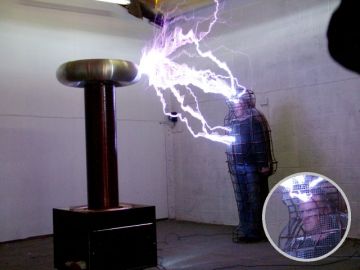June 7, 2005
A well grounded man
Interesting article at Slate about Survivors of Lightning Strikes.Don't Stand By MeThe Slate article goes on to tell the stories of a few other Strike victims and to describe some of the symptoms. Interesting in that no physical or neurological damage can be found by diagnosis but talking to a number of survivors, there is very much a common set of symptoms. From the Slate article again:
Surviving a lightning strike.
Jerry LeDoux is a guy you don't really want to interview, because interviewing him means having to be near him, and that's like planting yourself by a dartboard. The stone claw hanging from his neck attests to his grisly encounter with a bear's jaw at a roadside park in August 1990. (His wife, Bee, brandishes a photo album that documents the mauling before he's done telling the story.) The Purple Heart on his Navy Seals sniper hat testifies to the three bullets he took in Vietnam. The ugly black mark on his finger is evidence that he once air-nailed it to a floorboard. The scar on his left arm is proof that he accidentally screwed his flesh to the wall. The long knife wound on his hand? "Things happen," he says. The most improbable of his many accidents is the one that left the least visible evidence—just a few white splotches on his arms and a discoloration near his hairline. But that doesn't mean it's easily forgotten. LeDoux rolls up his sleeve to show off a tattoo of a man getting struck by lightning engraved on his left bicep.
All LeDoux remembers about the moment he was struck in August 1999 is that he was standing ankle-deep in a puddle when he was overcome by an intensely bright light. He woke up a half-hour later, 20 feet away, with a vague taste of battery acid in his mouth, he said. The soles of his shoes had melted, his two-way radio had exploded, and several of his teeth had shattered. The medical ID tag he wore around his neck was melted into his chest. He drove home from work that afternoon and was back on the job the next day. "I didn't even know I was hurt. I didn't realize anything was wrong," says LeDoux, a 62-year-old master mechanic from Sulphur, La. It took several weeks before he realized just how fried his circuits were—and almost six months to find a doctor who believed he'd been struck.
Tremors, mini-seizures, and sleep disorders are common symptoms. So are chronic pain and a lack of equilibrium. "I'm scared to death to get stopped on the highway because I can't walk a white line," says Bubba Babineaux. Many survivors experience intense headaches and a constant ringing in their ears. Some complain that they overheat easily. Babineaux, for instance, has shaved his head to compensate for a persistent feeling that he's about to spontaneously combust. In some cases, these symptoms don't appear until months or even a year after the accident. One widespread symptom is chronic irritability. "Anything would set me off," LeDoux says, with an unsettling glare, before explaining that he now takes nine medications to ease his pain. Lightning-strike survivors often talk about "mourning" their old selves.There is a support group:
Lightning Strike & Electric Shock Survivors International, Inc. (LS&ESSI, Inc.) is a non-profit support group by and for survivors, their families, and other interested parties.I have played with high voltage before and am in the process of accumulating the parts for a fairly large Tesla Coil.

Mine will be about the same size and performance.) I have not Danced with the Serpent yet and do not plan to. High Voltage is not House Current -- it plays by its own rules -- you need to learn a different set of safety procedures. Posted by DaveH at June 7, 2005 8:46 PM